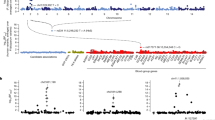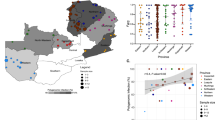Abstract
Genetic factors are known to have a role in determining susceptibility to infectious diseases1,2, although it is unclear whether they may also influence host efficiency in transmitting pathogens. We examine variants in HBB that have been shown to be protective against malaria3 and test whether these are associated with the transmission of the parasite from the human host to the Anopheles vector. We conducted cross-sectional malariological surveys on 3,739 human subjects and transmission experiments involving 60 children and 6,446 mosquitoes in Burkina Faso, West Africa. Protective hemoglobins C (HbC, β6Glu→Lys)4,5 and S (β6Glu→Val)6,7,8 are associated with a twofold in vivo (odds ratio 2.17, 95% CI 1.57–3.01, P = 1.0 × 10−6) and a fourfold ex vivo (odds ratio 4.12, 95% CI 1.90–9.29, P = 7.0 × 10−5) increase of parasite transmission from the human host to the Anopheles vector. This provides an example of how host genetic variation may influence the transmission dynamics of an infectious disease.
This is a preview of subscription content, access via your institution
Access options
Subscribe to this journal
Receive 12 print issues and online access
$209.00 per year
only $17.42 per issue
Buy this article
- Purchase on Springer Link
- Instant access to full article PDF
Prices may be subject to local taxes which are calculated during checkout

Similar content being viewed by others
References
Hill, A.V. Aspects of genetic susceptibility to human infectious diseases. Annu. Rev. Genet. 40, 469–486 (2006).
Alcaïs, A., Abel, L. & Casanova, J.L. Human genetics of infectious diseases: between proof of principle and paradigm. J. Clin. Invest. 119, 2506–2514 (2009).
Williams, T.N. Red blood cell defects and malaria. Mol. Biochem. Parasitol. 149, 121–127 (2006).
Agarwal, A. et al. Hemoglobin C associated with protection from severe malaria in the Dogon of Mali, a West African population with a low prevalence of hemoglobin S. Blood 96, 2358–2363 (2000).
Modiano, D. et al. Haemoglobin C protects against clinical Plasmodium falciparum malaria. Nature 414, 305–308 (2001).
Allison, A.C. The distribution of the sickle-cell trait in East Africa and elsewhere, and its apparent relationship to the incidence of subtertian malaria. Trans. R. Soc. Trop. Med. Hyg. 48, 312–318 (1954).
Allison, A.C. Protection afforded by sickle-cell trait against subtertian malarial infection. BMJ 1, 290–294 (1954).
Hill, A.V. et al. Common west African HLA antigens are associated with protection from severe malaria. Nature 352, 595–600 (1991).
Quintana-Murci, L., Alcais, A., Abel, L. & Casanova, J.L. Immunology in natura: clinical, epidemiological and evolutionary genetics of infectious diseases. Nat. Immunol. 8, 1165–1171 (2007).
Haldane, J.B.S. Disease and evolution. Ric. Sci. Suppl. 19, 68–76 (1949).
Kwiatkowski, D.P. How malaria has affected the human genome and what human genetics can teach us about malaria. Am. J. Hum. Genet. 77, 171–192 (2005).
Modiano, D. et al. Haemoglobin S and haemoglobin C: 'quick but costly' versus 'slow but gratis' genetic adaptations to Plasmodium falciparum malaria. Hum. Mol. Genet. 17, 789–799 (2008).
Robert, V. et al. Effect of the sickle cell trait status of gametocyte carriers of Plasmodium falciparum on infectivity to anophelines. Am. J. Trop. Med. Hyg. 54, 111–113 (1996).
Arie, T., Fairhurst, R.M., Brittain, N.J., Wellems, T.E. & Dvorak, J.A. Hemoglobin C modulates the surface topography of Plasmodium falciparum-infected erythrocytes. J. Struct. Biol. 150, 163–169 (2005).
Fairhurst, R.M., Fujioka, H., Hayton, K., Collins, K.F. & Wellems, T.E. Aberrant development of Plasmodium falciparum in hemoglobin CC red cells: implications for the malaria protective effect of the homozygous state. Blood 101, 3309–3315 (2003).
Fairhurst, R.M. et al. Abnormal display of PfEMP-1 on erythrocytes carrying haemoglobin C may protect against malaria. Nature 435, 1117–1121 (2005).
Tokumasu, F. et al. Band 3 modifications in Plasmodium falciparum-infected AA and CC erythrocytes assayed by autocorrelation analysis using quantum dots. J. Cell Sci. 118, 1091–1098 (2005).
Ayi, K., Turrini, F., Piga, A. & Arese, P. Enhanced phagocytosis of ring-parasitized mutant erythrocytes: a common mechanism that may explain protection against falciparum malaria in sickle trait and beta-thalassemia trait. Blood 104, 3364–3371 (2004).
Friedman, M.J. Erythrocytic mechanism of sickle cell resistance to malaria. Proc. Natl. Acad. Sci. USA 75, 1994–1997 (1978).
Pasvol, G., Weatherall, D.J. & Wilson, R.J. Cellular mechanism for the protective effect of haemoglobin S against P. falciparum malaria. Nature 274, 701–703 (1978).
Cholera, R. et al. Impaired cytoadherence of Plasmodium falciparum-infected erythrocytes containing sickle hemoglobin. Proc. Natl. Acad. Sci. USA 105, 991–996 (2008).
Trager, W. & Gill, G.S. Enhanced gametocyte formation in young erythrocytes by Plasmodium falciparum in vitro. J. Protozool. 39, 429–432 (1992).
Trager, W., Gill, G.S., Lawrence, C. & Nagel, R.L. Plasmodium falciparum: enhanced gametocyte formation in vitro in reticulocyte-rich blood. Exp. Parasitol. 91, 115–118 (1999).
Hayward, R.E., Tiwari, B., Piper, K.P., Baruch, D.I. & Day, K.P. Virulence and transmission success of the malarial parasite Plasmodium falciparum. Proc. Natl. Acad. Sci. USA 96, 4563–4568 (1999).
Williams, T.N. et al. An immune basis for malaria protection by the sickle cell trait. PLoS Med. 2, e128 (2005).
Verra, F. et al. Haemoglobin C and S role in acquired immunity against Plasmodium falciparum malaria. PLoS One 2, e978 (2007).
Vermeulen, A.N. et al. Sequential expression of antigens on sexual stages of Plasmodium falciparum accessible to transmission-blocking antibodies in the mosquito. J. Exp. Med. 162, 1460–1476 (1985).
Price, R. et al. Risk factors for gametocyte carriage in uncomplicated falciparum malaria. Am. J. Trop. Med. Hyg. 60, 1019–1023 (1999).
Walsh, P.S., Metzger, D.A. & Higuchi, R. Chelex 100 as a medium for simple extraction of DNA for PCR-based typing from forensic material. Biotechniques 10, 506–513 (1991).
Ye, S., Dhillon, S., Ke, X., Collins, A.R. & Day, I.N. An efficient procedure for genotyping single nucleotide polymorphisms. Nucleic Acids Res. 29, E88–E8 (2001).
Gouagna, L.C. et al. Stage-specific effects of host plasma factors on the early sporogony of autologous Plasmodium falciparum isolates within Anopheles gambiae. Trop. Med. Int. Health 9, 937–948 (2004).
Tchuinkam, T. et al. Experimental infections of Anopheles gambiae with Plasmodium falciparum of naturally infected gametocyte carriers in Cameroon: factors influencing the infectivity to mosquitoes. Trop. Med. Parasitol. 44, 271–276 (1993).
Wilson, K. & Grenfell, B.T. Generalized linear modelling for parasitologists. Parasitol. Today 13, 33–38 (1997).
Acknowledgements
We are grateful to the study participants for their understanding and cooperation and to the laboratory and field staff of the IRSS/Centre Muraz of Bobo Dioulasso and of the Centre Medical Saint Camille of Ouagadougou, Burkina Faso, for skilled work, logistics and collaboration. We are indebted to the staff of the IRD Antenne de Bobo Dioulasso for logistic support. We thank G. Modiano, V. Petrarca, B. Arcà and M. Coluzzi for continuous advice and L. Ranford-Cartwright and E. Ferraro for statistical support. This work was funded by grants from the EU, Sixth Framework Programme, BioMalPar Network of Excellence, LSHP-CT-2004-503578 and from the Istituto Pasteur–Fondazione Cenci Bolognetti, University of Rome 'La Sapienza'.
Author information
Authors and Affiliations
Contributions
L.C.G. organized and supervised the parasitological and entomological surveys in the Bobo Dioulasso area. G.B. performed parasitological, entomological and genetic surveys in the Bobo Dioulasso area. F.Y. and B.Y. participated in parasitological, entomological and genetic surveys. K.R.D. participated to entomological surveys. J.S. organized and performed the parasitological and genetic survey in the Ouagadougou area. J.B.O. coordinated the study in the Bobo Dioulasso area. D.M. proposed the scientific hypothesis and organized and coordinated the study. L.C.G., C.C., J.B.O. and D.M. designed the research procedure. L.C.G., G.B., J.B.O. and D.M. analyzed and interpreted the data. D.M. and L.C.G. wrote the paper. All authors discussed the results and commented on the manuscript.
Corresponding author
Ethics declarations
Competing interests
The authors declare no competing financial interests.
Supplementary information
Supplementary Text and Figures
Supplementary Tables 1–5 (PDF 220 kb)
Rights and permissions
About this article
Cite this article
Gouagna, L., Bancone, G., Yao, F. et al. Genetic variation in human HBB is associated with Plasmodium falciparum transmission. Nat Genet 42, 328–331 (2010). https://doi.org/10.1038/ng.554
Received:
Accepted:
Published:
Issue Date:
DOI: https://doi.org/10.1038/ng.554
This article is cited by
-
Immune responses to P falciparum antibodies in symptomatic malaria patients with variant hemoglobin genotypes in Ghana
BMC Immunology (2024)
-
Influence of the sickle cell trait on Plasmodium falciparum infectivity from naturally infected gametocyte carriers
BMC Infectious Diseases (2023)
-
Sickle cell trait enhances malaria transmission
Nature Microbiology (2023)
-
Risk score prediction model based on single nucleotide polymorphism for predicting malaria: a machine learning approach
BMC Bioinformatics (2022)
-
Machine learning model for malaria risk prediction based on mutation location of large-scale genetic variation data
Journal of Big Data (2022)



